 |
|
Here and There introduces art, artists, galleries, museums, and other cultural facilities around Japan that non-Japanese readers and first-time visitors may find of particular interest.
|
|
 |
|
|
 |
 |
Osawa no Sato: A Taste of Rural Tokyo a Century Ago
Alan Gleason |
 |
Rice paddies flooded in preparation for spring planting below the bluff at Osawa no Sato in Mitaka, Tokyo. The roof of the farmhouse can be seen through the trees at far left. |
Yes, there is a rural Tokyo. Today, suburban sprawl covers most of the flat land from the city center to the foothills of the Kanto Range, but not so long ago you could find bucolic landscapes just a few miles west of downtown. I grew up in such an area, the Osawa district of the Tokyo suburb of Mitaka.
It was a pretty idyllic place for a kid. We had the free run of acres of woods and pastureland. At the bottom of a steep bluff just below our house were wasabi patches, rice paddies, and a meandering stream, the Nogawa. Today housing developments encroach from all sides, but miraculously, a little bit of the old Osawa survives. On a few acres straddling the Nogawa you can find the region's oldest functioning mill wheel, a beautifully restored Meiji-era farmhouse, and even an ancient tomb. The complex, Osawa no Sato ("Osawa Village"), is operated by the Mitaka City government, which deserves kudos for giving contemporary Tokyoites the opportunity to savor what life was like just beyond the city limits only a few decades ago.
Osawa has been populated by humans for at least 27,000 years. Fresh water and perhaps the stunning view of Mt. Fuji induced people of the Jomon culture (14,000-300 BCE) to form several communities atop the bluff here, a geological formation known as the Kokubunji Escarpment that was carved by the ancient meanderings of the Tama River (now several miles to the south). Sometime in the late 7th century a large number of group tombs were dug into the hillside in Osawa. One particularly large cavern, Deyama Lateral Hole Tomb No. 8, discovered in 1979, held several skeletons. Today the entrance is covered with plexiglass and lit from within, so you can peer inside and see meticulously molded plastic replicas of the bones as they were found strewn across the tomb floor.
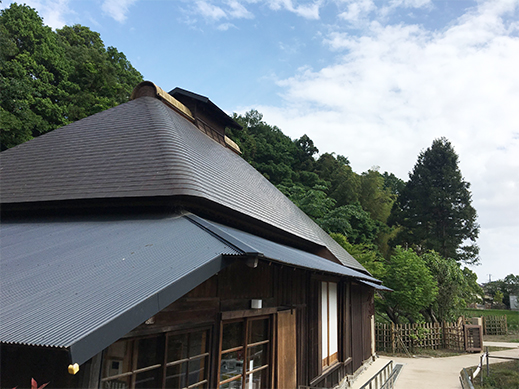 |
|
The Osawa no Sato Kominka, a farmhouse built in 1902. Everything except the roof has been restored to its original condition. Inside, display panels and videos relate the history of wasabi cultivation in Osawa and the process of restoring the house. |
Just downhill from Tomb No. 8 is the Osawa no Sato Kominka ("old house"), a spacious dwelling built in 1902 by descendants of Kobayashi Masaemon, an employee of the Shogunate who moved to Edo from Ise in the early 1800s. Masaemon discovered that the bluff that ran through Osawa created the perfect conditions for growing wasabi, which requires a steady supply of clean water. Rain falling on the blufftop seeps down through soft Kanto Loam, a volcanic ash that makes an excellent filter, reaching the bottom of the slope months later, where it flows out through tiny springs into the Nogawa. Masaemon brought some wasabi seedlings from Ise, built a network of stone walls and water channels along the base of the bluff, and did a thriving business in wasabi, thanks to the growing popularity of sashimi in Edo. Remnants of the walls can be seen here and there; they are most visible where local volunteers are cultivating a revived wasabi patch right behind the Kominka.
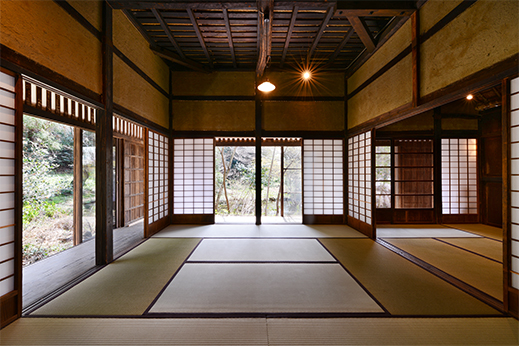 |
|
Partitioned by translucent paper shoji screens, the expansive interior opens onto a pastoral vista of wasabi patches, rice paddies, and the bluff in back. |
The house was still the private residence of Masaemon's descendants as recently as 1980. In 2007 the family donated it to the city, which designated it a Tangible Cultural Propery. Restoration entailed dismantling the entire structure, then reassembling it with as many of the original materials as possible (over 90 percent were salvaged). The refurbished Kominka finally opened for public viewing in October 2018. Well worth the wait, the house offers visitors a welcome respite from the world outside. Spatious tatami-floored rooms (indicating that this was a pretty wealthy family) open onto shoji screen-framed views of the woods and fields outside. From this vantage point, it really appears as if time has stopped at some point around 1900. Overhead, thick age-darkened beams crisscross the space under the high ceiling, flanked by mud-plaster walls. Everything is in shades of brown. Upstairs, the space under the steep roof was used, as in farming communities throughout Japan, to grow silkworms as a winter income source. The restoration is so impeccable that few visitors are likely to be able to tell the difference between the original woodwork and the replacements (the guides are happy to point out examples). The only visible accommodation with modern times is the roof, which has copper sheeting covering the original thatch -- as required by current fire-prevention ordinances.
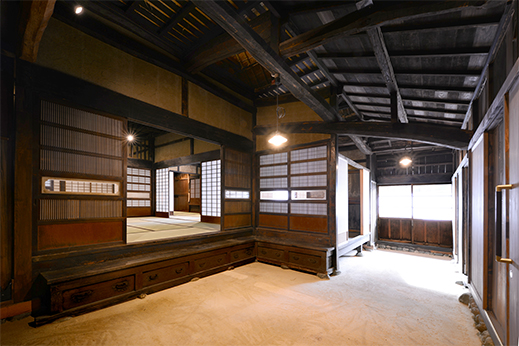 |
|
The doma earthen-floor entrance to the Kominka. Above the ceiling rafters is a large attic space that was used for silkworm cultivation. |
The strip of spring-moistened land between the bluff and the Nogawa, which flows parallel to it, was also a fertile place for rice cultivation. The paddies were still there when I first lived in the area in the late fifties, but have long since given way to houses, parks, and golf courses. However, Osawa no Sato has reintroduced an acre or two of paddy right outside the Kominka, enhancing the pleasurable time-warp effect of the entire landscape. Cared for by local volunteers, the fields offer schoolkids an opportunity to see and experience firsthand the various stages of rice cultivation.
Built in 1813, the main house of the Minegishi family, owners of the Shinguruma flour mill in Osawa, still carries the remnants of its thatched roof. |
Across the Nogawa from the farmhouse sits the most fascinating site in the "village": a fully restored flour mill, its centerpiece a massive pinewood water wheel, 4.6 meters in diameter, housed in a two-story shed. Built by the Minegishi family in 1808, the Shinguruma ("new wheel") is the oldest surviving mill in the greater Tokyo area, where water wheels sprang up in profusion with the development of rice paddies beginning in the late Edo era. Up until the 1960s the wheel was still being used to mill local grains -- not only rice and wheat, but also buckwheat for the famous Jindaiji soba, a specialty of the noodle shops that line the entrance to nearby Jindaiji, one of the Kanto region's oldest Buddhist temples.
To run the mill, water from the Nogawa was diverted to a sluice that passed under the building, driving the wheel from below. From there the water flowed through an underground tunnel into the nearby paddies. The wheel and its elaborate network of gears, shafts and pestles -- almost entirely made of wood -- is a sight to behold, and a tour with the guide on duty, who will explain the complete grain-milling process, is highly recommended. The wheel paddles, though highly durable (pine is quite water-resistant), must be replaced every few years. The current wheel was hand-built by local residents in 2009. Next to the mill building is the Minegishi residence, built in 1813 -- a full century before the house across the stream. As in the farmhouse, the attic here was also used for sericulture.
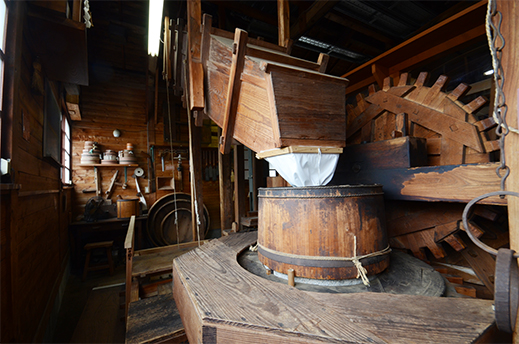 |
|
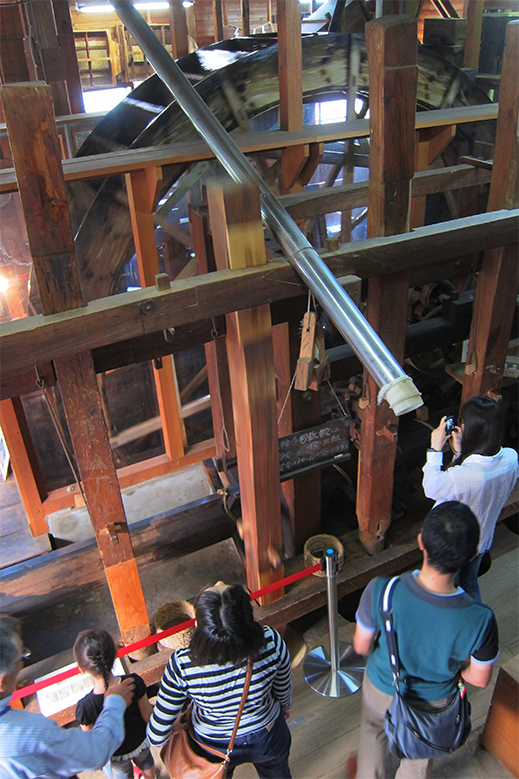 |
|
|
|
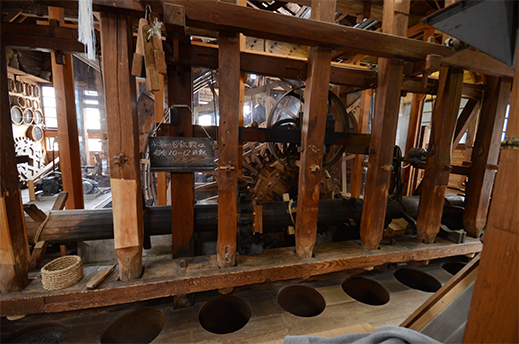 |
|
The entire mill mechanism, including the wheel, the grain chute, and the gears that run a battery of pestles to pound the grain into flour, is still operational. |
Within its relatively small acreage, Osawa no Sato offers a wealth of information about life in rural Tokyo a century ago, and even earlier. Most captivating of all, though, is the sensory experience afforded by the lovingly restored environment. Running clearer and cleaner than it did during Japan's postwar boom years, the Nogawa, too, is once again home to white egrets stalking through the shallows on the hunt for fish. The bluff, too steep to develop, survives as an oasis of greenery. The mill, the old houses, the paddies and wasabi patches conspire in the illusion that you are standing in the midst of an Edo-era landscape, unstuck in time. It is a place guaranteed to soothe the soul, particularly in times when our souls really need soothing.
While you're at it: Just uphill from Osawa no Sato, on the campus of International Christian University, is the Hachiro Yuasa Memorial Museum, which has an excellent selection of Jomon pottery excavated atop the bluff, as well as other displays about the geology and history of the Osawa area.
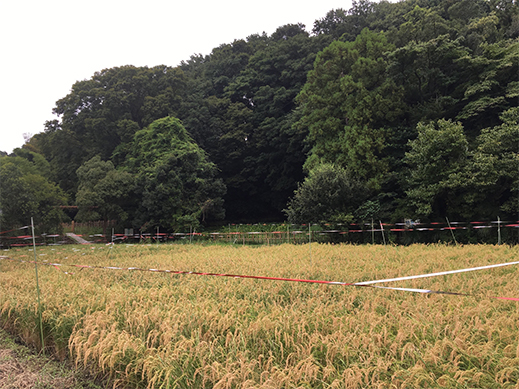 |
|
Rice ready to harvest at Osawa no Sato. |
All photos are courtesy of the Mitaka City Lifelong Learning Promotion Department and Parks and Green Zone Department.
 |
| Historical Spots of Mitaka (in English)
|
| Mitaka Osawa no Sato (in Japanese)
|
|
2-17-3 Osawa, Mitaka, Tokyo
|
| Mitaka Watermill "Shinguruma" (in Japanese) |
6-10-15 Osawa, Mitaka, Tokyo
Phone: 0422-45-1151 ext. 2921 (Mitaka City Lifelong Learning Promotion Dept.)
Open daily 10-5 (10-4 from November to March)
Closed Tuesdays (open if Tuesday is a public holiday, but closed the next day)
Access: 5-minute walk from Ryugenji bus stop, 20 minutes by Odakyu bus from the south exit of Mitaka station on the JR Chuo Line. Take a bus for Sakakibara Heart Institute, Asahicho Sanchome, or Kurumagaeshi-Danchi.
|
Hachiro Yuasa Memorial Museum (in English)
Note: Osawa no Sato is closed until 12 April as a measure against the further spreading of the coronavirus. Before planning a visit, please call or check the website for updated information. |
|
|
|
| |
 |
Alan Gleason
Alan Gleason is a translator, editor and writer based in Tokyo, where he has lived for over 30 years. Since 2006 he has edited Artscape Japan and written the Here and There column, as well as translating the Picks reviews. He also edits and translates works on Japanese architecture, music, and theater. |
|
|
|
|
|
|
|
|
|
 |
|